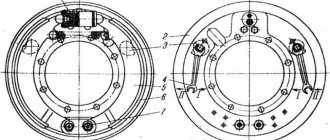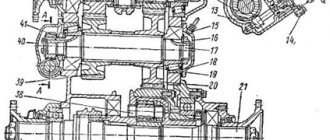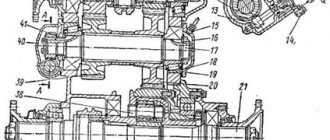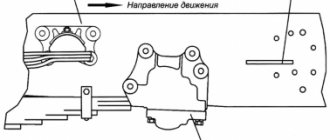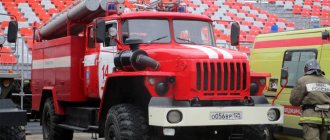Ural car maintenance
Maintenance of the Ural car is a preventive measure, carried out forcibly on a planned basis after certain runs or operating time of the car. In addition, the driver must constantly monitor the proper operation of all systems, components and assemblies of the vehicle and, without waiting for the next maintenance period, eliminate malfunctions.
During operation, it is necessary to perform the following types of maintenance: daily maintenance (EO), maintenance No. 1 (TO-1), maintenance No. 2 (TO-2), seasonal maintenance (SO).
The frequency of technical maintenance of TO-1 and TO-2 is established depending on the operating conditions of the vehicles. When operating vehicles in off-road conditions and in autumn-spring thaw, the gaps between the brake pads and drums must be adjusted after 1000-1500 km.
Maintenance 1 is carried out every 4 thousand km
Every 4,000 km, a Ural truck must undergo maintenance according to the TO-1 scheme. To perform maintenance at maintenance 1, you must do the following:
- Wash the power steering pump filter, check the oil level in the reservoir and top up if necessary. The oil level should be between the upper and lower marks with the plug open.
- Tighten the nut of the telescopic shock absorber housing (later tighten if a leak appears).
- Lubricate the clutch release clutch bearing and the clutch release fork shaft bushing.
- When driving on our roads, and even more so off-road, vibration and shaking can weaken the fastenings of the main corners and mechanisms. To avoid breakdowns, tighten the fastenings of all main components - the power unit, air intake and exhaust systems, step-ladder nuts of the front and rear springs, nuts of the wedges for fixing the pins of the front springs and the ears of the front springs. Remember, it is necessary to tighten the nuts of the spring ladders on a fully loaded vehicle.
- Check the tension of the steering pump drive belt. The deflection should be from 7 to 13 mm.
- Brake linings are subject to constant wear, so adjust the gap between the brake pads and drums. After adjustment, the brake drums should not become hot.
- Check the level and density of the electrolyte in the batteries. If necessary, add distilled water and recharge the battery. The electrolyte level should be within 10-15 mm above the safety shield.
- It is recommended to periodically clean the surface and ventilation openings from dirt and dust. Check that the contacts of the wire tips are securely attached to the battery.
- Pump in grease until fresh grease emerges from the pin and eyelet interface of the front spring. When working with a trailer, do the same with the tow bar bushing. Remove excess grease with a rag.
- Check and, if necessary, bring the lubricant level in the steering knuckle housings of the front drive axle to normal. The lubricant level should reach the edge of the inspection filler hole. Oil leakage through the plugs is not allowed.
- When carrying out TO-1 work, it is necessary to carry out maintenance of the power unit in accordance with the engine operating instructions.
Manual URAL-4320-60/61, URAL-43206-61, URAL-5557-60 AND THEIR MODIFICATIONS 2014 - page 8
41
stuffy filter, remove dust from the hopper lid. Wash the body and cover in diesel fuel or hot water, blow with compressed air and dry.
Inspect the air cleaner filter element. Dust deposits on the interior
side of the element indicates a leak in the element or sealing gaskets; in this case, replace it.
The quality of the seal is controlled by the continuous imprint on the gasket. To service the filter element, remove the pre-cleaner and clean it
remove dust by shaking or blowing. If you find dust without soot or soot on the element cardboard (gray element), blow it with dry compressed air until the dust is completely removed. To avoid cardboard breakthrough, the compressed air pressure should be no more than 200 —
300 kPa (2
-
3 kgf/cm
2
). Direct the air jet at an angle to the surface, the force of the jet is re-
adjust by changing the distance of the hose from the element.
If there is soot, oil, fuel on the cardboard or if the airflow is ineffective
compressed air, it is necessary to replace or wash the element in warm water (40—
50 °C) with a detergent dissolved in it (for example, household washing powders) at the rate of 20
-
25 g of substance per 1 liter of water.
Rinse the element by immersing it in this solution for half an hour, followed by intense rotation, or dipping it into the solution for 10 -
15 minutes. After washing in the solution, it is necessary to rinse the element in clean warm water and dry. Do not dry over open flames or air temperatures above 70°C.
After each maintenance of an element or when installing a new one, you should check
Check its condition visually by illuminating it from the inside with a lamp.
In case of mechanical damage, ruptures of corrugated cardboard, peeling of cardboard
tone, tears in the sealing gaskets, replace the element.
The estimated service life of the cardboard filter element is
30,000 km. Excessively frequent cleaning of the filter element reduces its service life, since the total number of element maintenance is limited (5 to 7 times, including washing no more than 3 times) from —
for possible destruction of cardboard.
You should periodically inspect the condition of the rubber connecting corrugations
lined and smooth sleeves. If defects are detected in the form of cracks, cuts, ruptures, etc., replace the parts.
5.1.2 Engine preheating system 5.1.2.1
The engine preheating system is designed to warm up
engine at negative ambient temperatures.
Technical characteristics of the pre-heater
Model PZD30ZH
Heating capacity, kW (kcal/h) 30 (26,000)
Fuel used for the engine
Fuel consumption, kg/h 4.2 The engine heating system includes: - pre-heater, consisting of: boiler 11, according to Figure 24, on -
pine unit 15 (electric motor, fan, liquid and fuel pumps); high voltage source;
— fuel tank 1 with tap 2; — heater control panel, consisting of switches: electric heating
va fuel, spark plugs, pump unit and solenoid valve. The remote control is located on the left side of the radiator of the cooling system;
— pipelines;
Maintenance 2 is carried out every 16 thousand km
When the mileage of a Ural truck approaches 16,000 km (and then every 16 thousand km), it must undergo extended maintenance or TO-2. It includes the entire scope of work performed during TO-1, as well as:
- Check and, if necessary, tighten the fastenings of the radiator, air filter and hose connections of the air intake system, and the fastening of the exhaust pipe muffler.
- Drain the fuel tank sediment and make sure there are no fuel leaks through the drain plug.
- Adjust the free play of the clutch pedal. It should be within 50-60 mm, in the absence of air pressure in the car’s pneumatic system.
- Tighten the fastening of the cardan shaft flanges and the fastening of the intermediate support to the beam; tighten the fastening of the main gears of the drive axles.
- Check the tightness and, if necessary, tighten the fastening nuts: the lever of the upper and lower covers of the steering knuckles and the flanges of the ball joints; reaction rod fingers; steering gear housing; steering shaft cardan forks; steering rod fingers; boosting mechanism.
- Check the tightness and, if necessary, tighten the bolts: upper reaction rod brackets; the balancer axle assembly to the balancer brackets; front brackets of the front springs to the lower flange of the side member; rear brackets of front springs to side member reinforcements; balancer brackets to the frame cross member; tie rods for the rear brackets of the front springs; fifth wheel to the subframe and frame (for truck tractors).
- Check the condition of tires, wheels and their fastening.
- Adjust the free play of the steering wheel and the toe-in of the front wheels.
- Check that the starter is securely attached to the engine.
- Check the condition of the insulation of electric drives and their fastening. If damaged, wrap the damaged areas with insulating tape.
- Check and, if necessary, tighten the fastenings of the power take-off, cab, platform and tail.
- Place the unloaded vehicle on a flat, horizontal platform and adjust the headlights.
- Check the oil level and, if necessary, add to the correct level: in the transfer case housing, intermediate support of the propeller shaft, in the main gears of the drive axles, in the rear balancer suspension hubs, in the steering gear housing. The oil level should reach the edge of the filler inspection hole. Oil leakage through plugs is not allowed
Using a lever-plunger syringe, according to the lubricants and working fluids map:
- Fill the upper bearings of the pins with lubricant through grease nipples in the amount specified in the lubricants and working fluids chart;
- Disassemble the splined joint of the steering propeller shaft and lubricate it;
- Lubricate the splined joints of the intermediate and middle axle drive shafts and the water pump bearings through a grease gun until fresh grease is squeezed out;
- Pump until fresh grease is squeezed out into the reaction rod joints. If the o-ring is significantly deformed, fresh lubricant is not necessary.
Specifications
| Overall dimensions of the car, mm | 7746x2550x3065 |
| External overall turning radius along the buffer, m | 11,4 |
| Service brake system | Double-circuit with pneumohydraulic drive |
| Cabin | All-metal, three-seater, equipped with a ventilation and heating system |
| Cabin | All-metal, three-seater. Equipped with a ventilation and heating system |
| Wheel formula | 4x4 |
| Control fuel consumption at a speed of 60 km/h, l/100 km | 24 |
| Maximum speed, km/h | 90 |
| Weight of transported cargo, kg | 3600*/4200 |
| Platform | Metal with side and rear folding sides, fittings for fastening the container body, equipped with removable arches and an awning, side folding and removable middle benches, attachment points for removed arches, awning, benches, sides |
| Total weight of the towed trailer, kg | 7000 |
| Total weight, kg | 11500*/12100 |
| Transmission | Five-speed gearbox, two-speed transfer case with center differential lock, rear axle with cross-axle differential lock |
| Fuel tank capacity, l | 210 + 60 |
| Ground clearance, mm | 400 |
| Tires | 425/85 R21 KAMA-1260, KAMA-1260-1, 390/95 R20 KAMA-Ural with adjustable pressure |
| Distribution of total vehicle weight, kg | |
| To the rear axle | 6545*/7490 |
| To the front axle | 4955*/4610 |
| Overcoming obstacles | |
| Brod, m | 1,75 |
| Climb, % | 58 |
| Engine | |
| YaMZ-236M2 | |
| Rated power at 2100 1/min, kW (hp) | 132 (180) |
* for a multi-purpose vehicle. At the customer's request, the vehicle can be equipped with a winch (maximum traction force 10-11 t.p., cable length 60 m), YaMZ-236BE2 engines with a power of 250 hp, YaMZ-236NE2 with a power of 230 hp. with a corresponding change in traction and dynamic characteristics.
Engine
For 2022, the YaMZ-236NE23 engine is installed in this car. It is characterized by the following main points:
- the fuel is ignited by compression;
- type - V-shaped;
- equipped with six working cylinders;
- equipped with turbocharging.
Its working volume determines cross-country ability. The size of the combustion chamber is 11.15 liters. Rated horsepower is 230. This is quite enough for driving over rough terrain and undeveloped roads. The maximum torque is 883 N*m, the nominal crankshaft speed is 2080 min-1.
The most important advantage of this engine is its unpretentiousness to the type of fuel. At the same time, it fully complies with the Euro-4 standard, which makes it possible to use this truck in European countries. The engine produces almost no environmental pollution. At the same time, it is important to remember that in winter you need to use special diesel fuel. Since the car's fuel line is not heated, it is not protected from freezing in any way.
Engine repair is not a serious problem. Since all the necessary spare parts are presented in stores, they are publicly available. Due to the simplicity of the device, operational repairs will not be difficult to carry out in the field. This is one of the reasons for the popularity of the car in the army.
— (this is the design of the block in CSS)
Ural-43206 was equipped not only with diesel engines, but also with gasoline engines - ZIL-375.
This engine has the following parameters:
- 180 hp;
- 8 working cylinders;
- The cylinder block is made of cast iron.
Most of the engine was made of aluminum. Which made it easy. Liquid cooling made it possible to “maintain” the nominal temperature even under heavy load in the hot summer. But a small number of models with a gasoline engine went into production. Since the consumption is relatively high, and the cost of gasoline is an order of magnitude higher.
Power system, fuel consumption
The power supply system does not have any serious features. Injection is carried out using an injector developed at the Yaroslavl plant. Main parameters of the fuel supply system in Ural-43206:
- fuel tank capacity - 300 l;
- additional fuel tank capacity - 60 l;
- air supply system - through a cardboard filter;
- exhaust gases - through a muffler;
- cooling system - liquid, with forced circulation and closed type.
Despite the rather impressive power, the car is relatively “economical”. At an average speed of 60 km/h while driving along the chassis, the consumption for every 100 km of travel is approximately 24 liters. This indicator is set for ideal conditions. That is why when driving over rough terrain it may differ slightly.
Transmission
The unique operation of the transmission is another reason for the popularity of this car. The clutch is dry, friction type, with a diaphragm type spring. It is produced at the same plant where the engine installed in the Ural-43206 is assembled. A manual gearbox is used.
This box is designated as YaMZ-236U. Automatic transmissions are not installed on this car model for a number of different reasons. The gearbox itself is five-speed. There are 4 speeds for forward movement and one for reverse movement. Synchronizers are installed in all gears except first. There is a transfer case.
The transmission of torque to the wheels through the box is carried out using a cardan shaft. This greatly simplifies the process of servicing the entire chassis. The cardan itself is of an open type; hinges on needle-type bearings are used. Gear shifting is carried out by disconnecting the gearbox from the engine using the clutch. The algorithm is standard.
The following types of the Ural-43206 vehicle were produced for various needs:
- equipped with 2 bridges;
- equipped with 3 bridges.
Chassis
When assembling this car, the frame is stamped and riveted. Ural-43206 is equipped with special towing devices at the front and rear:
- Rigid towing hooks are mounted in the front part of the body;
- in the rear part of the body there is a traction coupling device.
The front and rear suspensions are equipped with special semi-elliptic springs. There are double-acting hydraulic shock absorbers. There is a spare wheel holder at the rear of the cab. The chassis allows both the driver and passengers outside the cabin to feel relatively comfortable.
Load capacity, tire size, ground clearance
This model is also popular due to its load capacity and excellent cross-country ability, depending on the type of tires used. Dimensional and mass parameters:
- wheelbase size - 4,405 mm;
- length - 7,902 mm;
- width excluding rear view mirrors - 2,965 mm;
- height with fully loaded weight - 2,965 mm;
- vehicle load capacity - 4 tons;
- permissible total weight - 12 tons.
ID-P284 tires are used as standard. Their dimensions are as follows: 1200*500-510. Overall dimensions may vary slightly depending on the body type and other factors. The varieties are shown in the pictures below.
Extended maintenance 2 every 32,000 km
At every second maintenance-2, i.e. every 32,000 km, additionally do the following:
- Check and, if necessary, adjust the rear power unit mount.
- Check and adjust the tapered bearings of the primary and intermediate shafts of the transfer case. The axial movement of the primary and intermediate shafts should be 0.03 - 0.08 mm.
- Inspect the frame. There should be no loosening of rivet joints, cracks in side members or cross members.
- Make sure there is no axial movement of the balancer and correct the problem if necessary.
- Check the operation of the service brake system malfunction alarm.
- Make sure that the outlet pressure from both sections of the brake valve is equal to the system pressure and check the operation of the triple safety valve.
- Check the pressure level at the connection head of the single wire actuator (black). The air pressure on the control pressure gauge should be 480-530 kPa (4.8-5.3 kgf/cm2). When the service or parking brake is applied, the control pressure gauge should show “0” pressure.
- Check the pressure level at the connection supply head (blue). The air pressure on the control gauge should be 0. When the service or parking brake is applied, the control gauge should indicate the pressure in the system.
- Make sure that the free play of the brake pedal is within the normal range - 20-30 mm. Adjust if necessary.
- Check the operation of the brake force regulator (PTC). The pressure on the control pressure gauges must correspond to the value according to the RTS table.
- When working with a trailer, check and, if necessary, eliminate the axial play of the towing hook; tighten the tow bar mount to the cross member.
- Check the operation of the single safety valve. Air must enter the trailer brake cylinder after the air pressure in the remaining cylinders reaches 550 kPa (5.5 kgf/cm2).
Types of maintenance
Based on the labor intensity and frequency of work performed, maintenance is usually divided into several types.
- Daily maintenance (DM) - carried out before each departure and after each return of equipment.
- Seasonal maintenance (SO) - allows you to prepare the car for operation in winter and summer, and therefore is carried out in autumn and spring, respectively.
- Maintenance during the initial period of operation is carried out after 50 hours of operation of the power plant or thousands of kilometers of the vehicle.
- First maintenance (TO-1) is performed after every 125 hours of operation of the internal combustion engine or 4,000 kilometers.
- Second maintenance (TO-2) is necessary after every 16 thousand kilometers or 5 hundred hours of operation of the power unit.
Please note that in the case of TO1/2, the values are given only for the first category of operating conditions. These parameters require adjustment when operating equipment in different climates and difficult conditions, which is regulated by GOST 21624-81, as well as the “Regulations on the maintenance and repair of motor vehicles.”
Additional work after 48 thousand km
After every 48,000 km traveled by a Ural vehicle, it is necessary to:
- Replace the lubricant in the transfer case housing and in the main gears of the drive axles. Fill the oil up to the edge of the filler control hole on the rear wall of the crankcase. Oil leakage through the plugs is not allowed.
- Using an oil can, lubricate the clutch drive intermediate bracket shaft until fresh grease appears.
- When working with a trailer, check the condition of the threads on the hook and nut of the towing device. If there is deformation of the thread, replace the hook and nut with new ones.
Every fourth maintenance 2
For every fourth TO-2 (64,000 km) it is recommended:
- Replace the pneumatic hydraulic brake booster (PGU) or repair it yourself. Remove and disassemble the PSU. Wash the “bucket” parts in kerosene, the parts of the main brake cylinder in alcohol or brake fluid. Lubricate before assembly. Replace cuffs with risks and hooks.
- Replace brake fluid. After pumping, add fluid to the reservoirs of the main brake cylinders to a level of 15-20 mm below the upper edge of the filler neck.
- Lubricate the threads of the parking brake adjuster by removing the rubber plug on the shield.
